Chenille fabrics are very soft to the touch and comfortable. Plus, these fabrics look highly luxurious as well. Due to their appearance, the fabric is now being widely used in garments and upholstery.
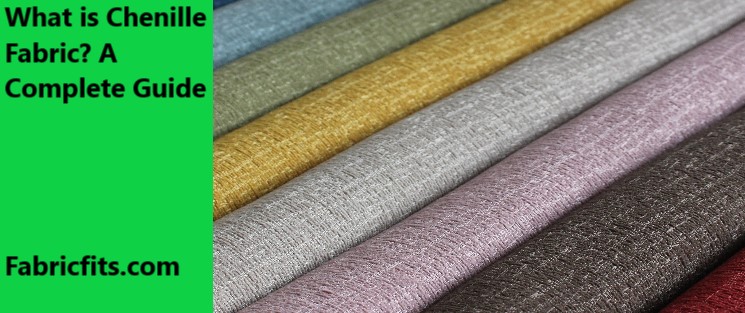
They are available in several colors and are extremely durable. Chenille fabrics are made of different fibers such as polyester, cotton, rayon, silk, wool, etc.
Whatever it is, if you’ve never heard of this and want to know what is chenille fabric, this very guide is going to give you an in-depth idea of this versatile fabric.
Table of Contents
- What is Chenille Fabric Made of?
- How Is Chenille Fabric Made?
- What Does Chenille Feel Like?
- What Does Chenille Look Like?
- Chenille Fabric Uses
- Advantages and Disadvantages of Chenille:
- Difference between chenille and other fabrics
- How to Care and Clean Chenille Materials:
- Frequently Asked Questions
- Final Words
What is Chenille Fabric Made of?
Chenille yarns are made of different natural and synthetic fibers, and when the yarns are woven, they produce chenille fabric. The most commonly used material for chenille yarn is cotton because it makes the fabric extremely soft and very comfortable to touch.
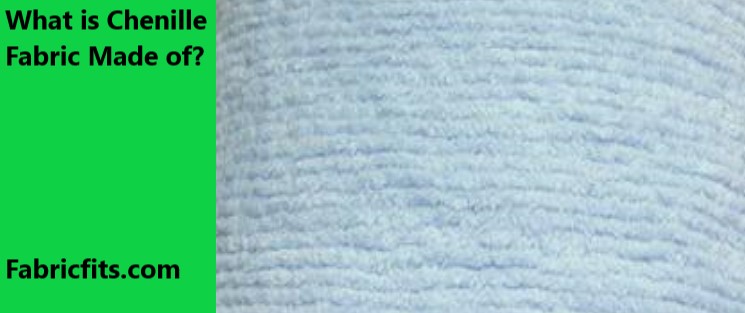
Therefore, cotton chenille fabrics are the best when it comes down to covering the skin such as blankets, garments, shawls, throws, etc.
Apart from that, wool, silk, olefin, rayon, and acrylic fabrics are also used in chenille yarn production. In some cases, chenille fabric is made of mixed materials as well.
Now you are probably wondering how this fabric is made, right? Check out the next section.
How Is Chenille Fabric Made?
With time, the making process of chenille fabric has changed. Once it was all by hand and hand-made tools. But since the establishment of the Chenille International Manufacturing Association, the production process has been modernized.
Even though many changes came into this fabric production, the basics remain the same. Here’s how chenille fabrics are made:
- One short yarn is placed in between two core yarns and then all three yarns are twisted all together
- Twisting the yards forms a pile and to keep the pile together, low-melt nylon is applied to the core
- After that, the yarn is properly steamed for staying as it is
- When the yarn is ready, it’s woven, and then comes the chenille fabric
- Adding low-melt nylon to the core is a recent invention since it saves the fabric from bare patches. Before that, yarns are only twisted and steamed.
What Does Chenille Feel Like?
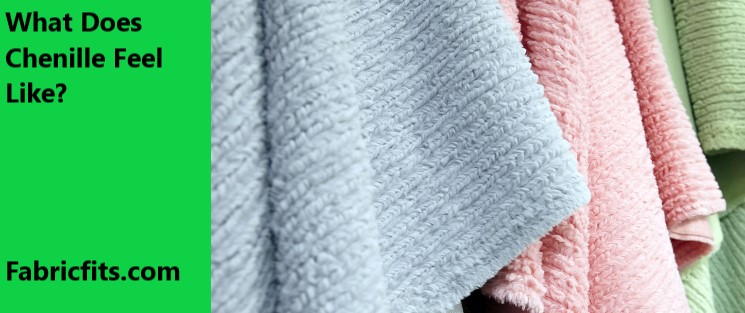
Chenille fabric has piles that form a fuzzy texture and feel very soft and plushy to the touch.
What Does Chenille Look Like?
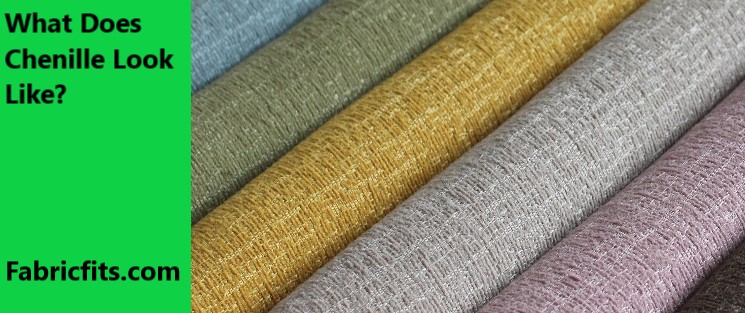
The piles in the chenille fabric make it look like a caterpillar which is a worm.
Chenille Fabric Uses
Though once the usage of chenille fabric was limited to a few items, now it’s being widely used in various things. Here are the most common uses of chenille fabrics.
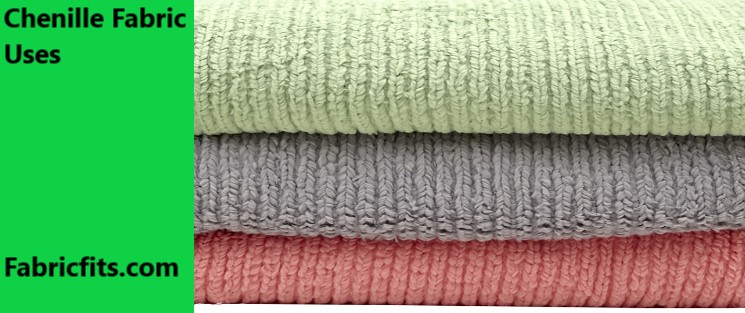
Clothes
With the increase in chenille production, now this fabric is widely used in garments such as dresses, sweaters, blouses, jackets, etc. Chenille fabric is a popular choice for sweaters as they are soft to the touch and provide insulation as well.
Decor
Due to its softness and attractive look, chenille fabric is used in drapes, pillows, bedspreads, upholstery, window coverings, and couches too.
Rugs
Along with comfort, chenille fabrics offer good durability too, therefore, they’re one of the popular materials for rugs and carpets.
Blankets
Dense chenille fabrics have a plushy texture which feels very comfortable and offers good insulation as well. Due to that, they’re an excellent choice for blankets.
Shawls
As this fabric is soft to the touch, looks good, and keeps warm, it’s used in making shawls.
Quilting
People have been using chenille fabric for quilting since 1990. It looks attractive, keeps warm, is durable, and feels very comfortable.
Advantages and Disadvantages of Chenille:
Chenille fabrics come with both advantages and disadvantages. Check them to find out if they are worth choosing or not.
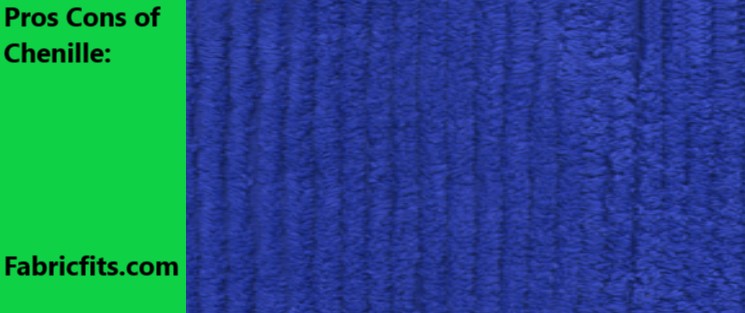
Chenille Fabric Advantages
- Though it’s hard to maintain chenille fabrics, if maintained well, these will last for years.
- Chenille fabric looks very attractive which is why they’re now widely used in garments.
- These fabrics can keep warm, which makes them a popular choice for sweaters and blankets.
- They offer excellent drapes and that makes them suitable for shawls and curtains.
- Chenille fabrics can be used in making many household items such as bedspreads, pillows, curtains, couches, chairs, etc.
- Can absorb water very quickly and easily.
- Comes in several colors, allowing you to choose your desired one.
Chenille Fabric Disadvantages
- The biggest con of chenille fabrics is, it’s hard to clean if something is spilled onto them.
- If exposed to sunlight, the fabric color can fade.
- This fabric can’t be ironed easily.
- After washing the fabric, it might shrink or deform and once it happens, there’s no going back.
- The fabric will lose its elasticity very easily when stretched.
- It takes good effort to wash these fabrics properly.
- Chenille fabrics are thick and have high water absorbency, therefore, take a long to dry.
- Pet claws can get caught on the piles, which will lead to damage.
Difference between chenille and other fabrics
Now let’s have a look at how better chenille fabric is compared to some other most popular fabrics.
Chenille vs Microfiber
The biggest difference between microfiber and chenille is cleaning. It’s very hard to remove stains off the chenille, whereas removing stains is easy in microfibers. Plus, chenille fabrics are heavy which makes washing them very tiring.
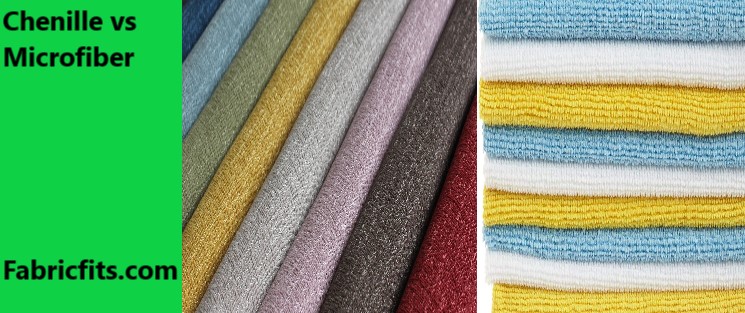
In terms of durability, chenille and microfiber both fabrics are almost similar, they are extremely durable.
However, unlike chenille microfiber doesn’t lose elasticity on a few stretches. Nor does it shrink as easily as chenille.
The water absorbency of chenille is very high compared to microfiber; therefore, they take more time to dry.
Both these fibers look very attractive, however, due to their shiny appearance chenille looks more attractive. Compared to microfiber, chenille fabric is a little more expensive.
Chenille vs Velvet
Chenille and Velvet, both these fabrics look premium, however, chenille is still the pricier one. They are available in various colors and have multiple uses. But when it comes down to providing warmth, chenille easily outweighs velvet.
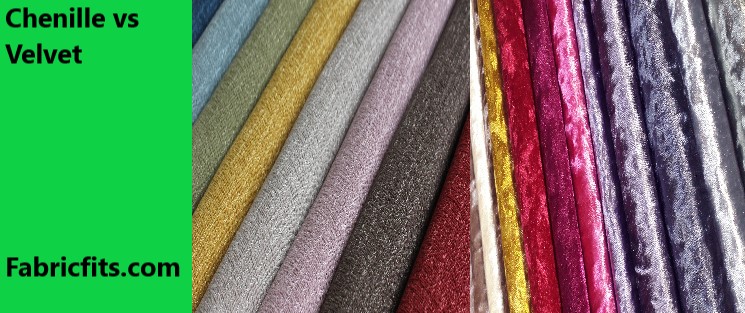
In contrast to chenille, it’s extremely easy to take off stains from velvet. Since velvet is thin, they’re easy to wash as well.
In terms of durability, chenille fabric is ahead of velvet. But that being said, velvet doesn’t deform or shrink like chenille.
Chenille vs Polyester
Chenille fabrics are made of different fibers, and polyester is one of them. Therefore, if the chenille fabric is made of polyester, then it is almost similar to polyester.
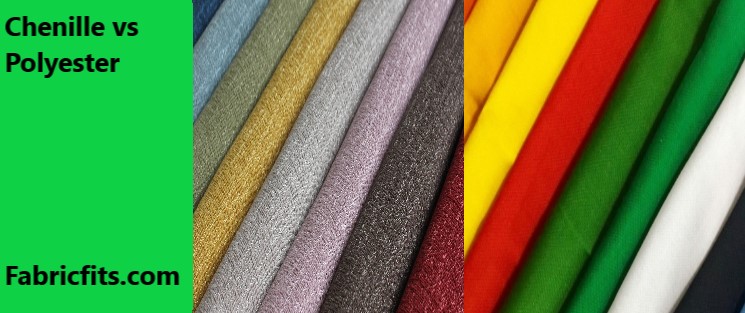
But since chenille fabrics are woven differently than polyester, the latter one might be less durable than the chenille.
If we compare chenille fabric that’s not made of polyester fiber, then it’ll be superior to polyester fabrics in most areas.
However, when it comes down to cleaning, polyester fabrics take the crown.
Chenille vs Cotton
As mentioned before, chenille fabrics can be made of polyester, cotton, rayon, and other fibers. If we compare a 100% cotton-made chenille fabric with cotton fabric, then the major difference between them would be the durability.
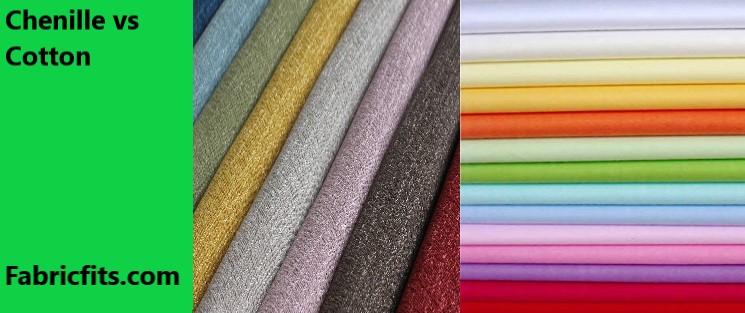
The weaving technique of chenille fabric is superior to cotton fabric; therefore, chenille fabrics are more durable.
Another difference is the cleaning process. Compared to chenille, it’s easy to clean cotton fabrics due to their weaving process.
How to Care and Clean Chenille Materials:
Maintaining and cleaning chenille materials is indeed a tough job. You need to be careful in each step. Let us show you how it’s done!
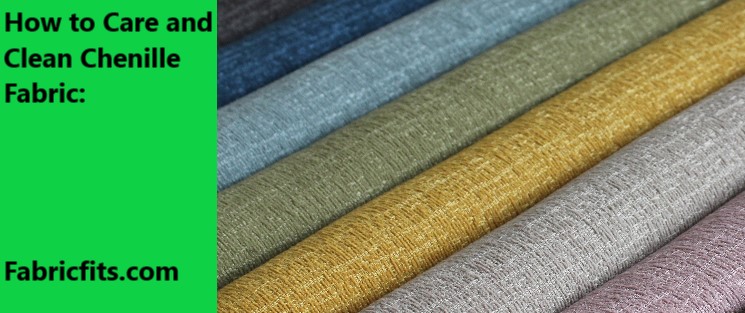
Maintaining Chenille Fabrics
There are some do and don’ts that you need to know if you want the chenille fabric to be in good condition for a long time.
- Never ever wash a chenille fabric in a washing machine, or you’ll be cutting down the lifespan by half at least.
- It’s best to not water wash chenille, as that can cause the fabric to shrink or deform.
- Be very careful what you spill on this fabric, taking off stains from chenille is a real head-scratcher.
- If you’re experienced, then don’t attempt deep cleaning the chenille-made upholstery, sofa, or any similar thing.
- Check the label before spot-cleaning chenille fabric-made rugs or carpets, if there is an “X”, then you shouldn’t deep clean it.
- Rotating and turning chenille-made cushions or pillows once in a while can increase the lifespan.
Cleaning Chenille Fabrics
Different manufacturers make chenille fabrics using different materials, therefore, it’s always best to follow the manufacturer’s recommended way of cleaning (if there is any).
But here we’ll take you through a basic cleaning process that you can follow if there isn’t any instruction from the manufacturer.
Cleaning Chenille Upholstery
To clean properly you’ll need an upholstery brush that isn’t rough and a powerful vacuum cleaner. Take the brush, and then gently rub it in a circular motion to remove the dust and dirt.
It’s easy to get carried away and put heavy pressure when brushing, with chenille fabrics, that’s an absolute no-go. Doing so will damage the piles and make the fabric look very bad.
Once you feel like you’ve taken out most of the dirt, time to bring the machine into action. Set the vacuum to its lowest setting and run the vacuum everywhere.
Spot Cleaning Chenille Fabric
When there is a stain on chenille fabric that requires spot cleaning. As the name suggests, it means cleaning a specific area.
You’ll require a cotton towel to do spot cleaning. Dampen the cotton towel, and then gently rub over the stained area. Be very careful when rubbing, since rubbing out of the stained area can stain the clean area as well.
If there are spills on the fabric such as sauce, cream, etc. First, take them off as much as possible with a spoon or something else. Then add a very little amount of water and then rub off the spills.
However, if the stain is stubborn, try stain removers.
Frequently Asked Questions
Is chenille durable?
Yes, chenille fabrics are extremely durable for their incredible weaving technique.
What is Rayon Chenille?
Chenille yarns are made of different fibers, and when it’s made of rayon fibers, it’s called rayon chenille.
Is chenille soft?
Yes, Chenille fabrics are very soft and comfortable. However, the softness depends on the fiber used in the making.
What is cotton chenille?
When chenille yarns are made of 100% cotton fiber, that’s called cotton chenille.
Is chenille warm?
Chenille fabrics provide excellent insulation, that’s why Chenille is a popular choice for blankets.
Is chenille fabric good for upholstery?
Chenille fabrics look very attractive and they’re durable too which makes them good for upholstery.
Is chenille fabric good for dogs?
Not at all! Chenille fabrics have piles where the dog claws can get caught very easily, thus, the fabric will get damaged. This fabric isn’t pet safe.
Is chenille expensive?
Yes, compared to most other popular fabrics, chenille is a little expensive due to its durability, comfort, and appealing appearance.
Final Words
The only flaw of chenille fabrics is the cleaning! It’s a daunting task to wash this fabric and take stains off. Plus, water washing causes most of these fabrics to shrink, which is not at all pleasing.
Apart from these, it’s an excellent fabric for many items. Whether it’s a pillow cover, curtain, upholstery, sweater, bedspread, or anything that requires fabric, chenille fabrics can easily blend in and bring a classy appearance.
However, if you want to know about chenille fabric, this guide should answer it along with most other useful information about chenille.

Question. I have a chenille bathrobe and have washed in washing machine many times. Recently the robe has become very heavy to even pick up and softness seems to be becoming less and less. Never realized you were not to wash clothing made from chenille but how would you keep a robe clean?
A quick shake or a spot clean with a damp sponge can keep your changing robe spick-and-span without having to resort to a full wash.